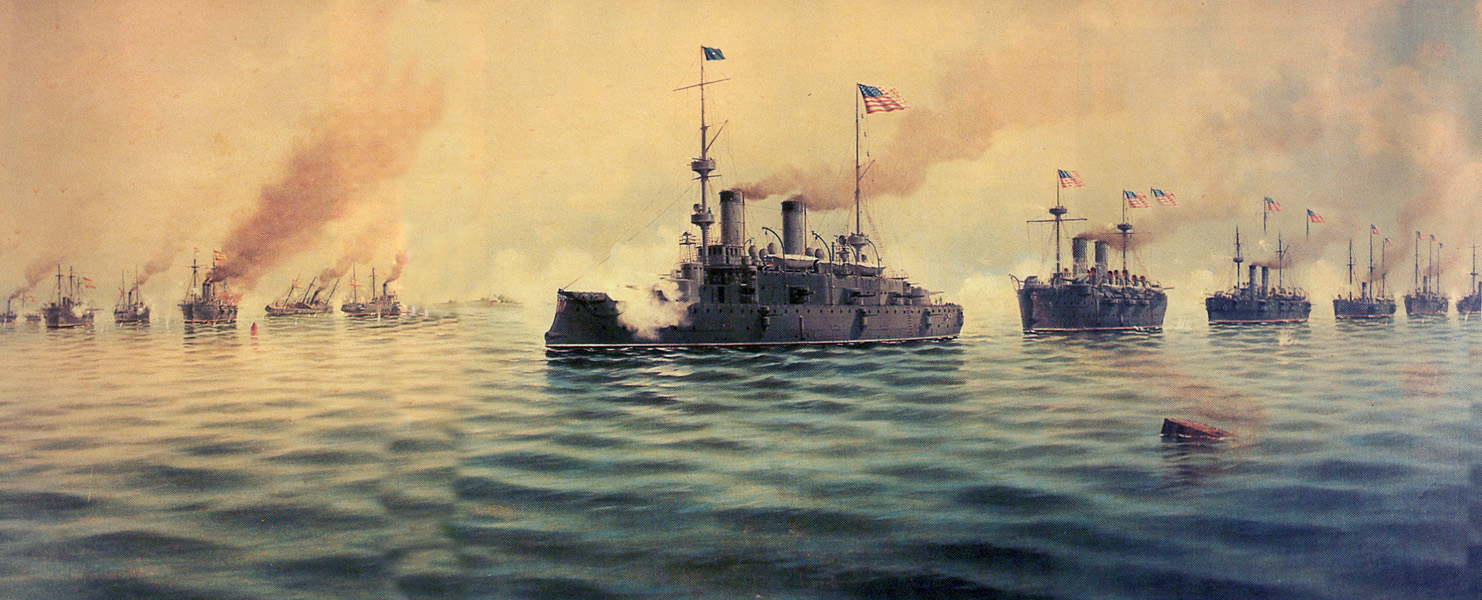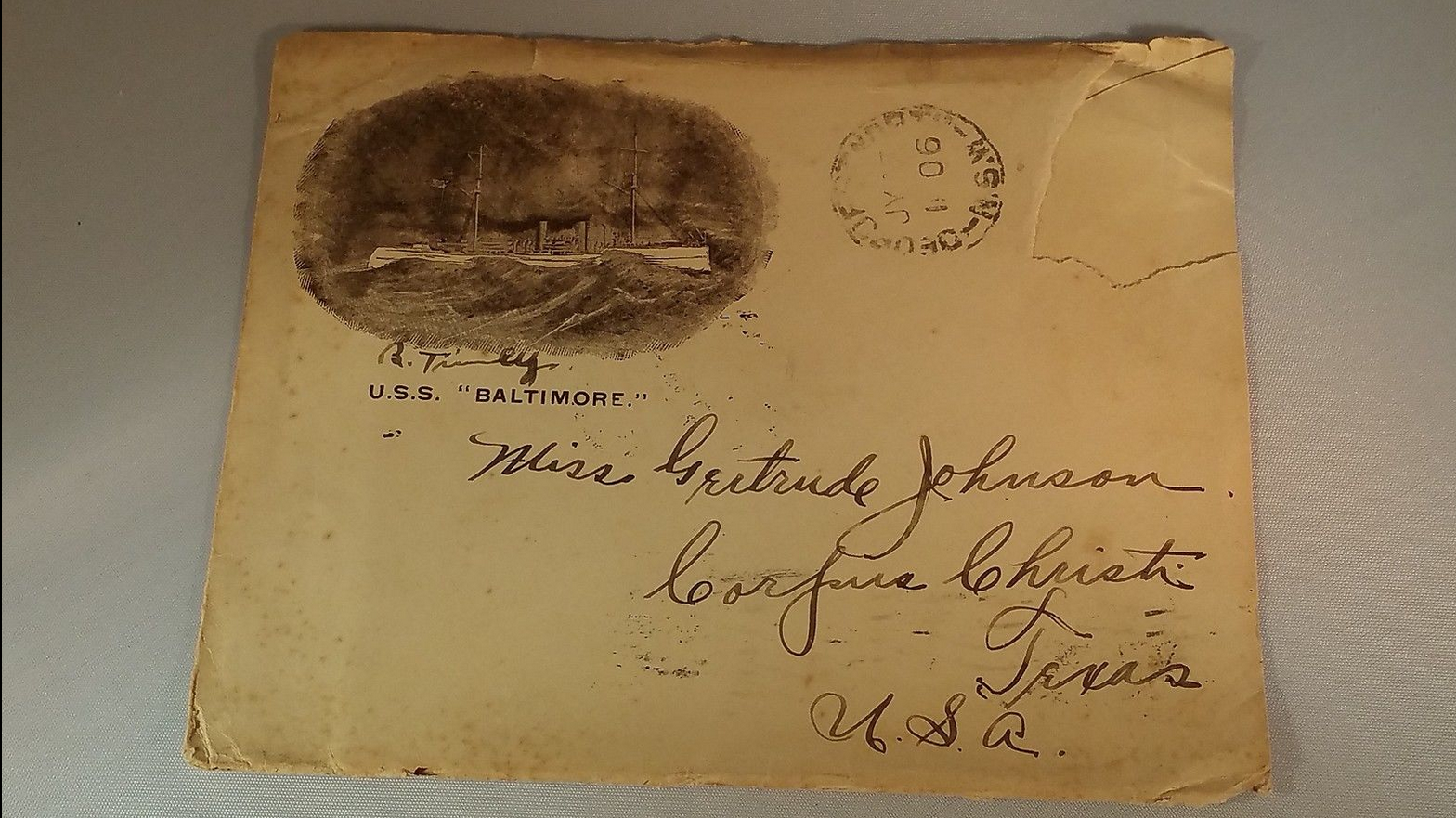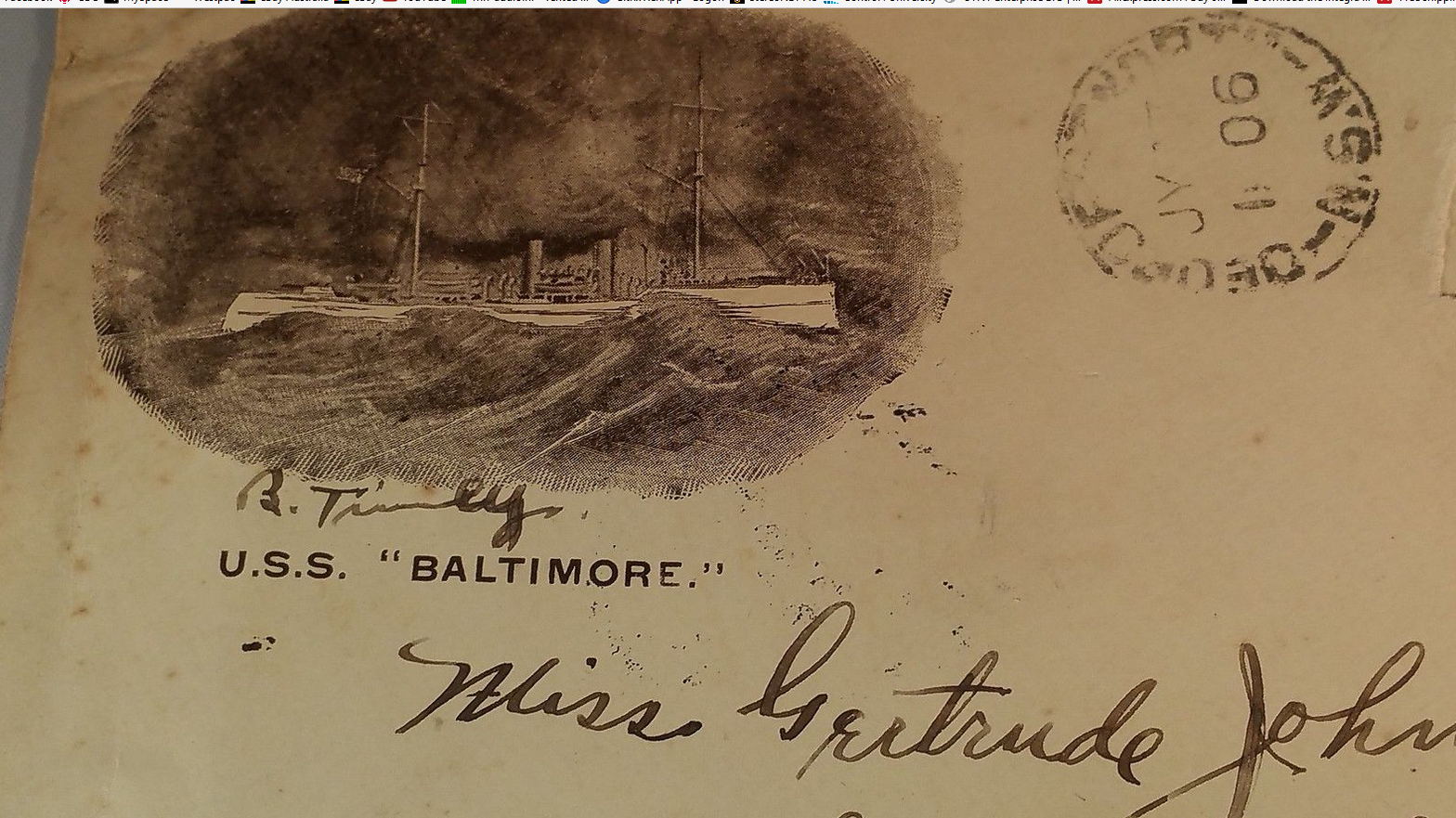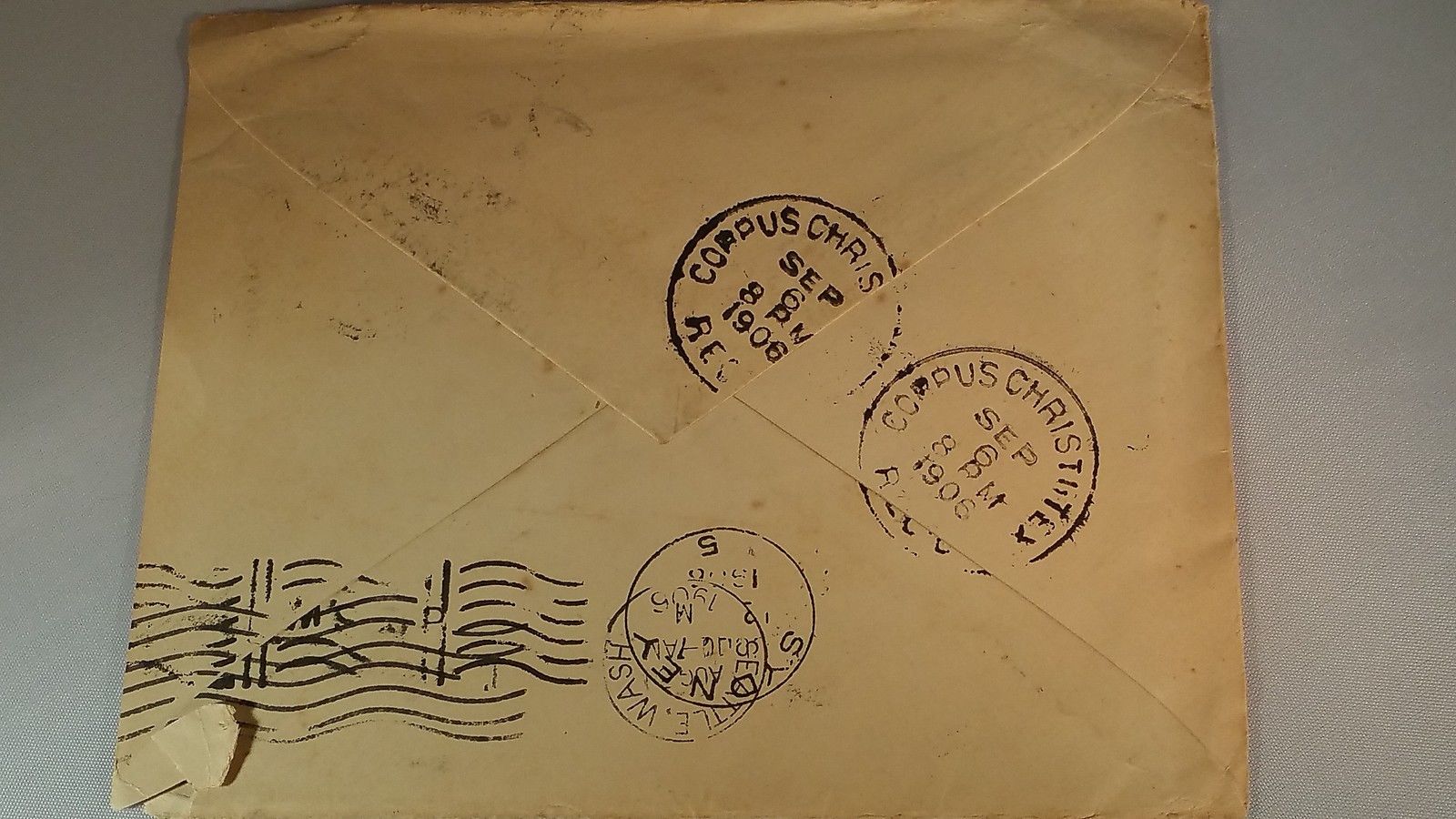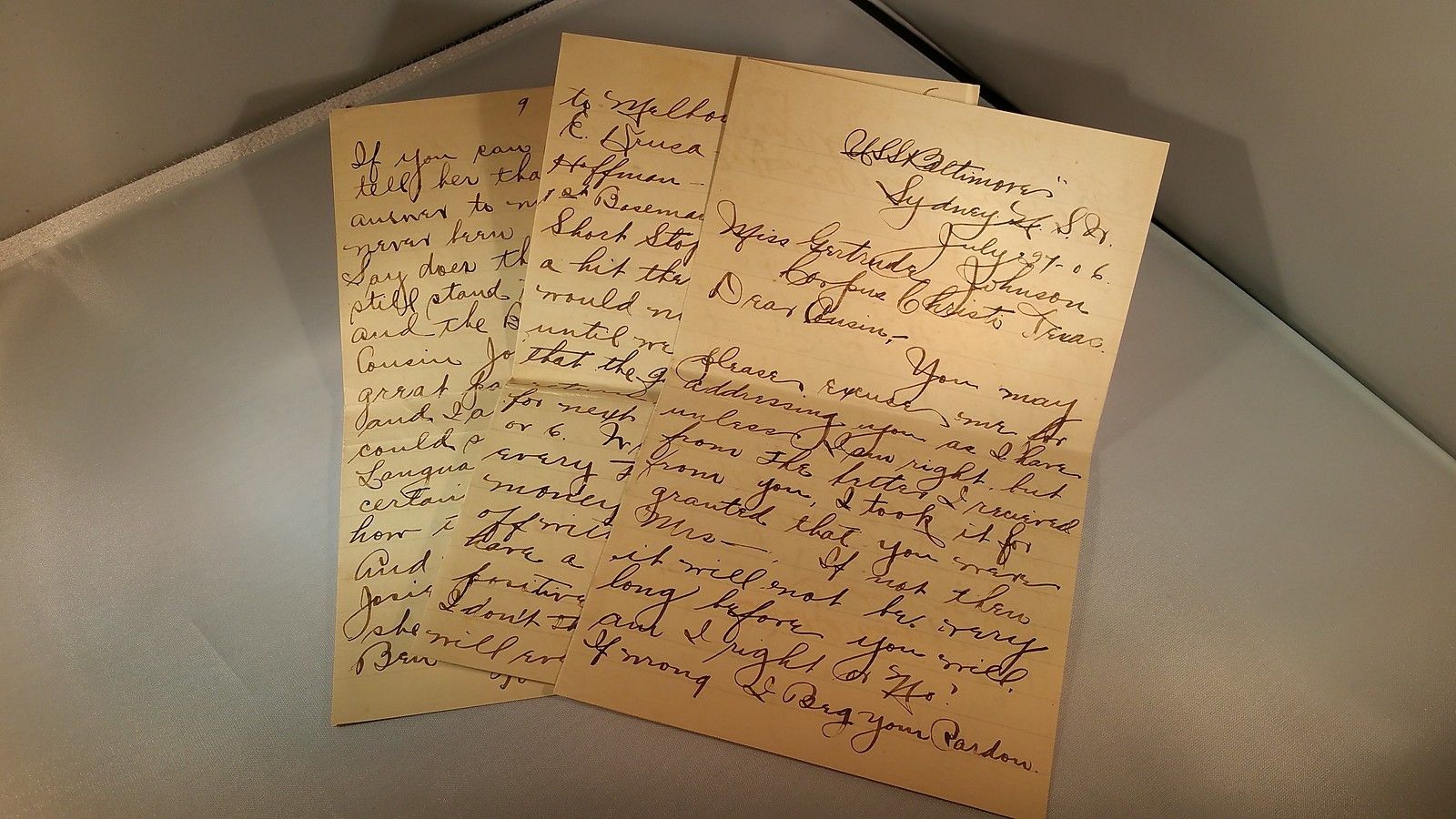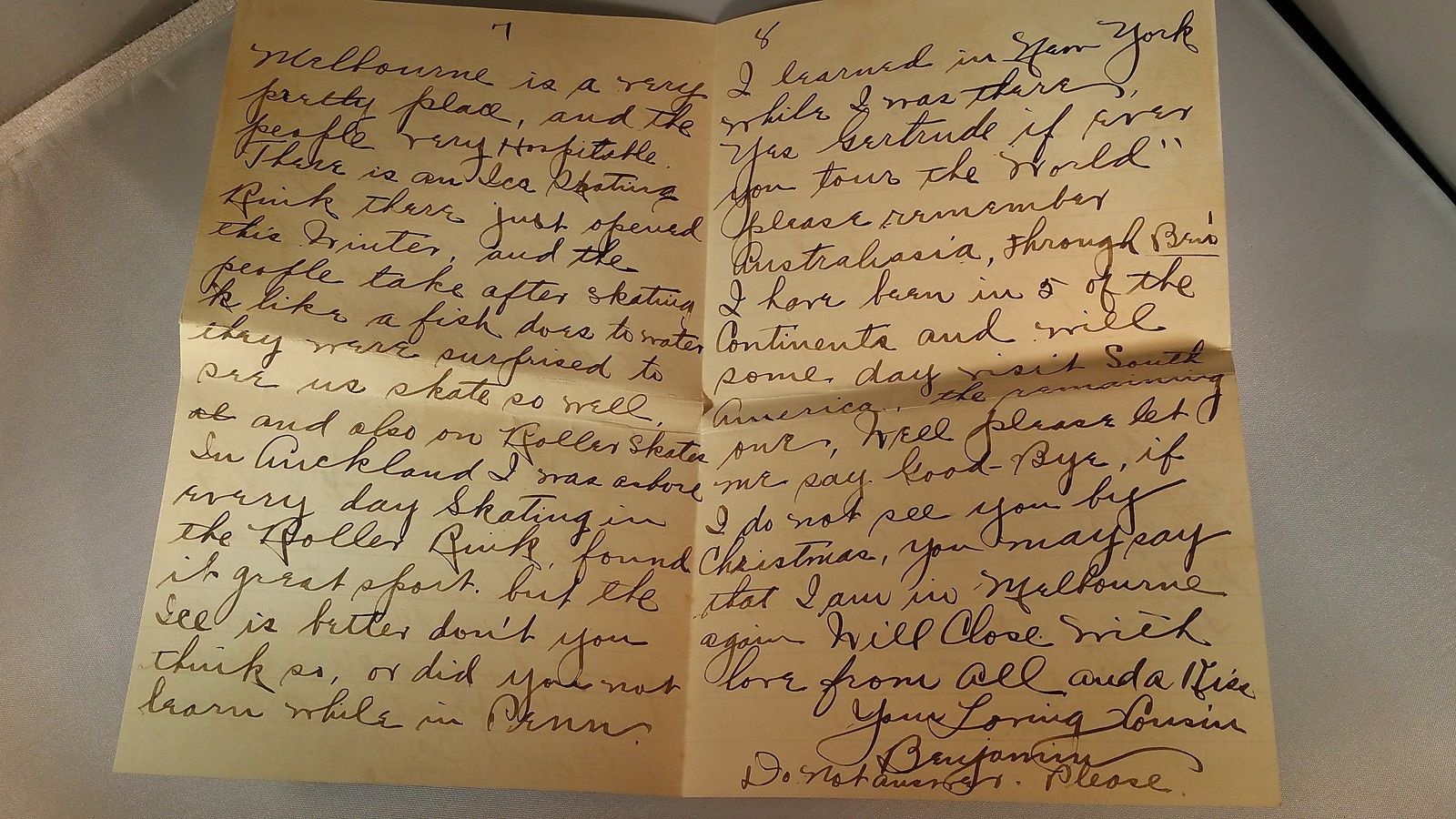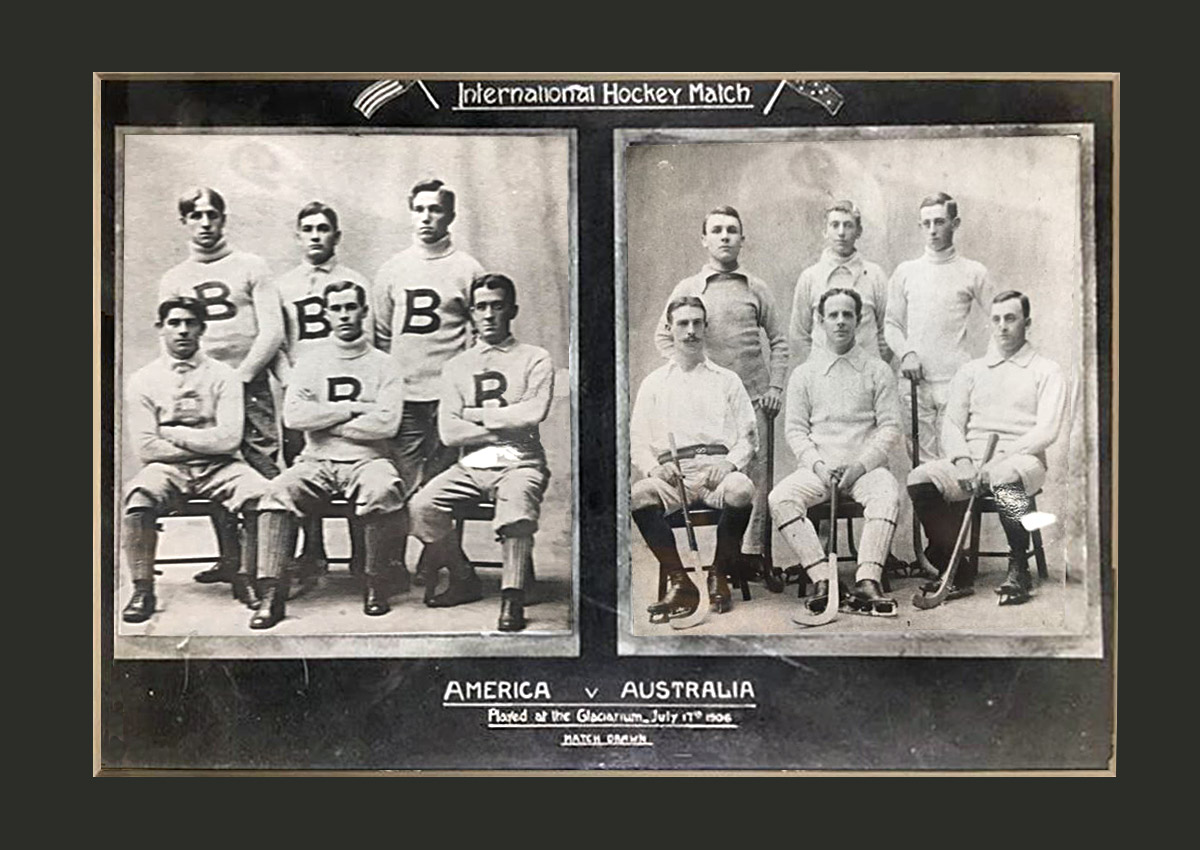
America tied Victoria, 1-1, in two 15-min periods at Melbourne Glaciarium, 9:00pm Tues evening, 17 Jul 1906. On the left, America (USS Baltimore), no particular order: F G Randell (captain and centre), H Stirling, T H Miller (half-back), J Benditti, D F Kelly (goalkeeper), J T Connolly (?-rush). On the right, Victoria: Standing, l to r: Gordon Langridge, C Kelly, Ramsay Salmon (left-rush). Sitting, l to r: Dunbar Poole (centre), Herb Blatchly (captain and goalkeeper), James Thonemann (half-back).Scorers: Vic: Poole; USA: T H Miller. Best player: T H Miller. Referee: James Brewer, Prince's Skating Club, London. A cropped version of the image was published in Punch, Melbourne, 19 Jul 1906, p 13.
Image courtesy Ross Fisher and Jason Sangwin (2018). The photo was a gift to Ross Fisher on the opening of Puckhandlers rink in Reservoir, today's iceHQ, from former Australian National Men's Team coach, Dan Reynolds.
Genesis: the first games
Melbourne Glaciarium 1906-1908
![]() Without the Canadian imports, ice hockey would never have undergone its commercial revolution in the 1930s, but it came at a price: few Britons or Australians took up the game themselves, preferring instead to become spectators and consumers. Despite the rapid growth in public demand and the levels of investment, hockey was distinctly Canadian – a singular triumph, it might seem, of the soft power of an increasingly independent nation. But it was controversial. British newspapers tired of having to explain anew each season who the players were, where they’d come from, and maintaining a mental geography of Canada’s small-town teams. They tired too of the violence that Canadians brought to the game. As the Skating Times put it, hockey was "suffering from an overdose of Canadian semi-professionals with big ideas about themselves". To counter the violence, officials set about changing the rules to improve respect for referees and reduce the number of bodychecks and slashes. The Canadian press interpreted the moves as a sign that British hockey was losing its "Canadian flavour". One British newspaper responded politely by asking "the many Canadians playing this season in England to remember that the game is sport rather than civil war".
Without the Canadian imports, ice hockey would never have undergone its commercial revolution in the 1930s, but it came at a price: few Britons or Australians took up the game themselves, preferring instead to become spectators and consumers. Despite the rapid growth in public demand and the levels of investment, hockey was distinctly Canadian – a singular triumph, it might seem, of the soft power of an increasingly independent nation. But it was controversial. British newspapers tired of having to explain anew each season who the players were, where they’d come from, and maintaining a mental geography of Canada’s small-town teams. They tired too of the violence that Canadians brought to the game. As the Skating Times put it, hockey was "suffering from an overdose of Canadian semi-professionals with big ideas about themselves". To counter the violence, officials set about changing the rules to improve respect for referees and reduce the number of bodychecks and slashes. The Canadian press interpreted the moves as a sign that British hockey was losing its "Canadian flavour". One British newspaper responded politely by asking "the many Canadians playing this season in England to remember that the game is sport rather than civil war".
— Dr Daryl Leeworthy, Huddersfield University [1]
![]() What happened when Britons or Australians and South Africans began playing ice hockey and then adapted it to their own sporting culture? What happened was a commercial revolution, was frustration with the limitations of amateurism, and a hostility set within the global hockey family by ambitious bêtes noirs. It all echoes with perfect mirrored similarity the frustrations and antagonisms felt a generation later when the rise of Sweden and the Soviet Union as hockey powers threatened the comfortable dominance of Canada. Then too, the Canadians disliked what they saw as a detrimental change to their game and the feeling that they could do little to control it. As historians seek to understand the development of hockey during the twentieth century and to expose the critical junctures at which the sport could have gone along the road less travelled, then perhaps their attention would be as well turned to the skaters of Sydney and Streatham. For hockey has always been more than Canada’s game.
What happened when Britons or Australians and South Africans began playing ice hockey and then adapted it to their own sporting culture? What happened was a commercial revolution, was frustration with the limitations of amateurism, and a hostility set within the global hockey family by ambitious bêtes noirs. It all echoes with perfect mirrored similarity the frustrations and antagonisms felt a generation later when the rise of Sweden and the Soviet Union as hockey powers threatened the comfortable dominance of Canada. Then too, the Canadians disliked what they saw as a detrimental change to their game and the feeling that they could do little to control it. As historians seek to understand the development of hockey during the twentieth century and to expose the critical junctures at which the sport could have gone along the road less travelled, then perhaps their attention would be as well turned to the skaters of Sydney and Streatham. For hockey has always been more than Canada’s game.
— Dr Daryl Leeworthy, Huddersfield University [2]
THERE WERE NO AIR HORNS, and no flashing red lights, just a shrill whistle from referee James Brewer of the Prince's Skating Club in London, and the players understood the first goal was official, scored by Miller for America. He was a first-class fireman from the American cruiser Baltimore on a goodwill tour of Australia. Judged the finest player on the ice at the brand new Melbourne Glaciarium, he was the ship's crack athlete — “a gymnast, a boxer, a skater and a football player worthy to rank in American first class”. [3] Dunbar Poole scored next to tie the first hockey game ever played on ice in Australia, 1-1.
It's not what you take, it's what you leave, and the American cruiser USS Baltimore left plenty when sailing Australian waters at the turn of last century. The war ship had won international acclaim in 1898 during the Spanish-American War at the Battle of Manila Bay. "Melbourne is a very pretty place," wrote crew member Benjamin Tinley to a cousin named Gertrude Johnson in Texas, "and the people very hospitable. There is an ice skating rink there just opened this Winter, and the people take after skating like a fish does to water. They were surprised to see us skate so well and also on roller skates". [19]
Recreational polo matches and some of the first ice sports had been played at the experimental rink in Adelaide the year before. Not surprisingly, these even included football on the ice, perhaps inspired by the oval-shaped ice surface, which was much smaller than the interstate rinks that followed on its heels. Or perhaps because a local newspaper quoting a "great English authority on skating" described ice hockey as a "game conducted on the same general principles as football, but it is football etherialised". [5] However, the Adelaide rink size, shape, open railings instead of boards, and a very thick structural column supporting the roof at centre ice, all conspired to make it rather awkward and dangerous for playing any competition team sports. The exhibition games there were not ice hockey but recreational novelties on a program designed to attract customers.
Unlike Adelaide, the first exhibition matches in Melbourne from 1906 and Sydney from 1908 were in fact hockey, not roller polo which Professor Caldwell, a local roller skating champion and ice skating instructor, had adapted to the small Adelaide rink. The Melbourne games were refereed by a professional skating expert from the London club where Prince's Ice Hockey Club, one of Britain's first, had begun playing nine years earlier in 1897. Brewer had been an instructor at Adelaide in the European off-seasons until his transfer to the Melbourne rink where he gave exhibitions of hockey on the ice from the moment it first opened. [7] But far greater skill than the Adelaide experiments was exhibited in Melbourne because for the first time hockey was able to be played against visiting teams from North America on a world-class rink designed for the modern North American game.
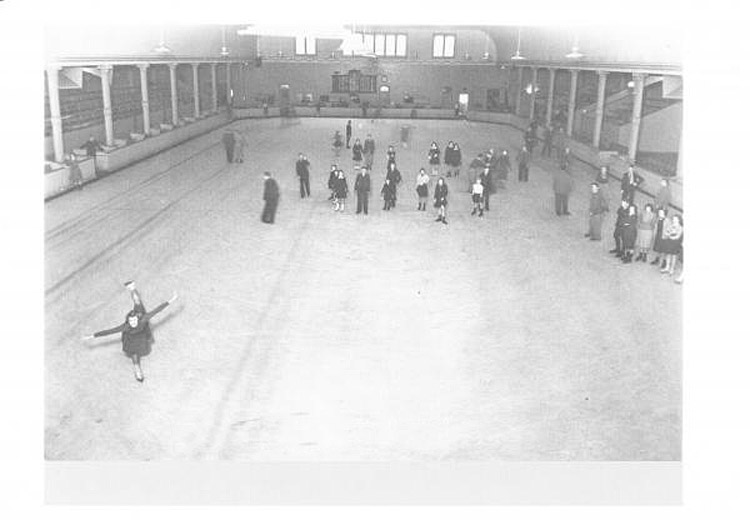
Melbourne Glaciarium interior view after remodeling, late-1930s.
Described as "grass-hockey, with wings added to it", the earliest hockey games were contested in two 15-minute halves. The local press reported, "The game in America is usually played with seven men but on this occasion six was the number." [9] The positions were similar to the positions in the early Canadian game: goal-keeper, half-back, full-back, centre, left-rush, right-rush. [9] Field hockey by comparison had a maximum eleven men with forwards, midfielders, and defensive players (fullbacks, halfbacks), while bandy with the same number of players and goalkeeper, had no other fixed positions.
They played "a little red ball" that "danced, spun and shot over the ice". Some of the Victorian players had skated in Adelaide and were good, but not yet as proficient as the Americans at "nursing the ball" on the end of the stick. Herb Blatchly, the London-born Canadian captain of Australia and its netminder, had grown up with the game in Toronto, but apparently his charges were not yet puckhandlers, they just hit the ball around. Body checks and falls were frequent and no man of the twelve had fifteen seconds spell during any part of the game, excepting when the goals were hit. Their faces "streamed with sweat and their breath came fast". [3]
The game played at nine o'clock on the evening of Tuesday, July 17th 1906 was the earliest known Australian record of a specific game of hockey on ice in a specific place at a specific time, and with a recorded score, between two identified teams. The Australians wore all-white uniforms, the Baltimore boys white shirts, grey trousers and red socks. It was a form of field hockey in transition to Canadian ice hockey that had preceded the International Ice Hockey Federation (IIHF) by two years, on a rink that complied with international and olympic standards, both back then and now. The players had prepared four weeks in advance and played at least one earlier match which the visiting Americans won, 5-0. The men from USS Baltimore also played baseball against Victoria at the MCG.
Ice hockey evolved here on a much smaller scale, but it was not dissimilar to Montreal during the 1870s when the modern Canadian game was first shaped. In fact, McGill University rules began life as essentially field hockey rules modified for ice. [4] The 1906 teams in Melbourne were photographed holding short wood sticks with heavy ends shaped in a broad curve. They were English field hockey sticks and the red ball was the size of a tennis ball, made of gutta-percha, a thermoplastic used in early golf balls. This Malaysian resin was also used for pucks in North America in those years. [6] It was more rigid than latex and did not become brittle, unlike rubber prior to the discovery of vulcanization some time later.
The Victorian Amateur (Field) Hockey Association was formed in 1906 with six clubs and in June the next year, The Australasian reported in Melbourne "a hockey match was played upon the ice, between teams from the Church of England Grammar School and the Victoria Hockey Club. After a spirited contest, the game resulted in a draw". [8] Melbourne Grammar's field hockey team played the Victoria field hockey club on ice then went on to produce players for Melburnian IHC, the most successful of the original four ice hockey clubs in Australia. This was not quite seven years after the first match usually considered an ice hockey contest in Europe, was played in London on March 16th 1900 between Cambridge and Oxford university ice hockey clubs at Prince's, Brewer's club.
However, it was played using bandy sticks and a lacrosse ball at Oxford's insistence. The following year, another Varsity Match was played at Prince's, this time with hockey skates and a puck. The next match at Blenheim Lake in 1902 was again a bandy match. To add to all the confusion, "hockey" was another name for bandy in the late 19th century, before Canadians exported modern ice hockey to Europe.
So, well may we now ask: were the 1906 Melbourne games the beginning of ice hockey in Australia? To answer that, we need to go back to the future and the frozen expanse of Kingston Harbour in Ontario where the game that launched ice hockey into its modern era was played. It was the first time on record that a puck and not a ball was used, distinguishing the game from field hockey on ice or its five other historical forms — ricket, shinty, lacrosse, hurling and bandy.
To be consistent, we should conclude the first modern ice hockey in Australia did not commence in Melbourne in 1906 if, indeed, it was played with a ball and not a puck. Yet, that is a little problematic 110 years on, because the first pucks were sometimes cut from balls in the early years and, from time to time, the local press wrongly referred to pucks as balls for a while after they were introduced. The ball reportedly in use in the 1906 Melbourne game was about the size of a tennis ball, or 65mm diameter, red in colour, and made from gutta-percha. [9]
The bandy ball is that diameter and colour, red being common in field games like bandy and cricket to distinguish ball from grass. However, the cricket ball should be discounted because its cork core was encased in stitched leather, not gutta-percha or rubber. The field hockey ball was a noticeably larger 75mm diameter. The historic bandy ball of the time met all three descriptive criteria of the Melbourne ball; size, colour and material.
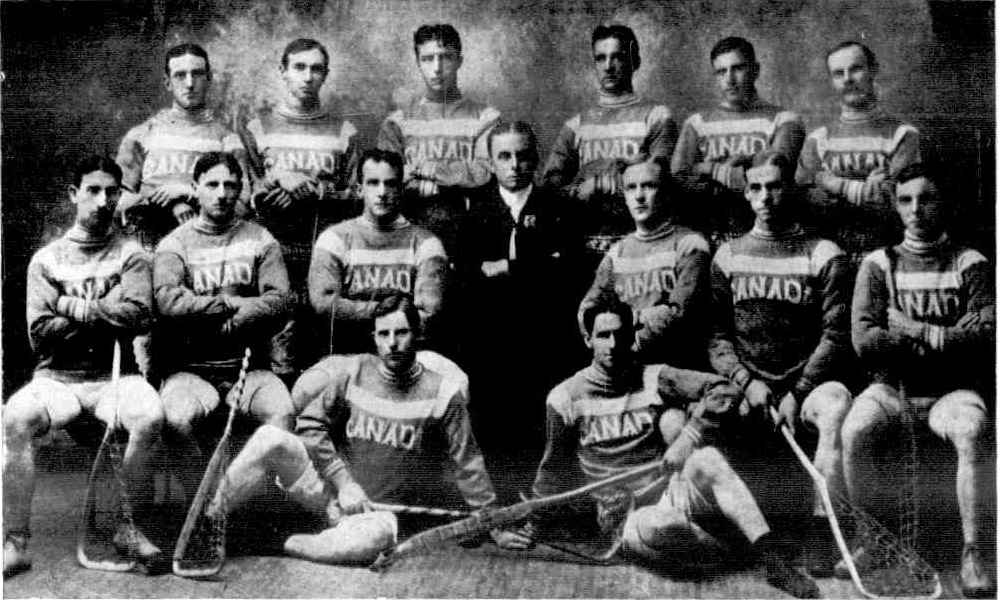
The Canadian Lacrosse Team, 1907. Played a team of Australian Lacrosse Players on the Melbourne Cricket Ground. Back row:- W. Alton, A. Rose, R. J. Arens, T Hanley, E. V. Graham, Dr. Campbell. Sitting:— H. Camplin, W. D. Ramone, W J Hanley (captain), J. M. Kearns, G. A Macdonald, R. Gilbert. Front Row.— F. J. Grace, F. E. Coombes. Photo by Fegan, Brisbane. [17] The Canadian's tour was sponsored by the State Lacrosse Associations of Australia, the Melbourne Cricket Club and the South Australian Cricket Association. The competitions included four test matches against Australia, two played at the MCG and witnessed by large spectator crowds, and two played at the Adelaide Oval. Canada won the Test Series by 3 matches to 1.
Technically, the first ice hockey with a puck on record in Australia began in Melbourne the next year, on August 12th and 13th 1907. This was Australia's first authentic encounter with Canada's game. Herb Blatchly again led the Australians. Gordon Langridge also returned but with a new group of players that included 16 year-old youngsters Bobbie Jackson, Hal Reid, and Errol Forster Woods, together with K Menzies and W S Campbell. [10] Their opponents in the familiar purple and white were the touring Canadian lacrosse team captained by M Grace with A Hanley, E Graham, T Hanley, R. Gilbert, Kerns and Macdonald. [10] Blatchly may have had links to the teams as the former secretary of the New South Wales Lacrosse Association until May 1904.
The Argus newspaper remarked that "good goalkeeping on the part of the Australians kept the score within reason", but their shots were less accurate and Canada won 13-1 [11] after forty minutes play. This game was described as "ice hockey", as distinct from "hockey on the ice" or "field hockey", and it was played with a "block which replaces the field ball". [11] One newspaper reported, "hockey on the ice is to the Canadian what cricket in the backyard is to the Australian, consequently there were few who expected the Victorians to win". [11] Canada won a rematch, 13-4, attended by the Lieutenant Governor, Sir John Madden who, on receiving the Canadians, told them he had "recently seen a championship game in Montreal". He was patron of the Victorian Lacrosse Association and his children were regulars at the Glaciarium.
Sydney Glaciarium opened that year and the hockey there was played with a hard rubber ball and field hockey sticks until replaced by the puck and imported Mic Mac (Mi’kmaq) sticks in 1908. [12] Back in Melbourne in 1908 the Victorians played against a visiting fleet of the US Navy, The Argus reporting, "... the effect of the visit of the Canadian lacrosse team a few months ago was plainly visible in the general play of the Victorians — their nursing of the 'puck' — as the hard disc of black rubber that serves the purpose of the ball is known — was far ahead of previous form...". [13] The 1908 series consisted of three organised games, also with known rosters and scores.
The Victorians were led for the third season by Blatchly, [13] with Bobbie Jackson and Dudley Forster Woods also returning, and C Smith, C Kelly, L De Grut and F Vale. The Americans were Ducy (Rhode Island), Dr Traynor (Georgia) Bardick (Kentucky), Brainard (Louisiana), Wood and Laigure (Virginia) and Gill (New Jersey) and perhaps other substituted players. The visitors were short for the third test decider, and so only five played each side.
The Americans were Selfridge (Virginia), Atkins and Burwick (Georgia), Gill (New Jersey) and Brainard (Louisiana). The Victorians were the three Reid boys — Hal, Andy and Leslie — Keith Curwen Walker and Dudley Forster Woods, all of whom went on to play Goodall Cup hockey from 1909. Victoria lost the first test, 9-2, but won the second 6-4, Jackson scoring a hat trick. They won the third game, 9-2, to take the series, 2-1, along with gold medals. [13] The locals were awe struck by the speed and skills of the North American game exhibited in these first three seasons, and none more so than the Reid boys.
The referee, James Brewer, was a professional instructor from Prince's Skating Club in London where Prince's Ice Hockey Club was founded 10 years earlier. Prince's is sometimes considered the first ice hockey club in Britain and it hosted the first match usually considered an ice hockey contest in Europe on March 16th 1900 between Cambridge and Oxford university ice hockey clubs. The first league in Europe formed there three years later and the Victorian Amateur Ice Hockey Association formed just 5 years after that in 1908, the same year as the International Ice Hockey Federation. Within a few years Australia had seven hockey clubs in Melbourne and Sydney, and the sport was "added to the number of interstate contests" in 1909. The Goodall Cup is still contested — the third oldest national ice hockey trophy in the world.
In Victoria at least, the new rules and equipment that were evolving for ice hockey were snapped up immediately, including sixty new 1910 Spalding Championship sticks and a dozen pucks which had been imported by a NSW supporter for the local players who had no desire to purchase them. [12] "Canadian rules" for all levels of play were adopted by the IIHF on March 14th 1911, but something similar had happened in Melbourne at least three years earlier.
Leeworthy wrote recently that Canada's game "was, above all, an amateur game that encouraged cultural engagement with Canada as those Australians who played hockey sought to mimic, lovingly, the style and atmosphere of Canadian hockey ... on the eve of the First World War, then, the skaters of Melbourne and Sydney had fashioned, in less than a decade, a vibrant sporting culture that provided entertainment for the thousands who turned up at the Glaciariums to watch." [1] Up to five thousand people crammed into three thousand seat rinks for the vicarious thrills of the amateur Goodall Cup clashes of the twenties and thirties. But perhaps more significantly, ice hockey also encouraged stronger trade, economics and bilateral political engagement with Canada.
It is remarkable that Australia remained defiantly amateur over the passing decades, dominated by two main cities on the Canadian model, despite strong links to Britain where hockey followed the professional game. Organizers here were at once unwilling and unable to professionalize the sport, despite numerous attempts. Professionalization has always been received with a hateful hostility, whether in the form of Bendrodt's Canadian Bears of 1938, the breakaway Victorian Hockey Ice League (VIHL) a decade later in 1948, or the National Ice Hockey League (NIHL) of 1981. Yet, Canadian expats were prime movers of all three, and that was rather odd given many Canadians accused American capital of spoiling their game as their National Hockey League (NHL) slowly Americanized.
The first commercialisation of Australian ice hockey. Bendrodt's Canadian Bears with Russ Carson in goal defeating Sydney Monarchs, 11-0, Ice Palais, Moore Park, Sydney, 1938. The Bears wore the light uniforms, which were red and white, the colours of Canada. Source: British Pathé
But the facts are that ice hockey was never just theirs. Ask Australia's first ice hockey captain, Herb Blatchly, and the dozens of touring Canadians and Americans who played the first Australian ice hockey in Melbourne between 1906 and 1908. You can't of course, because it was well over a century ago. But if they were still here today they would tell you the game was a partnership from the very beginning. A hybrid at best, according to Leeworthy, and especially in Australia.
![]()
Special thanks to Jason Sangwin for use of the photographs of the Baltimore letter.
Napoleon's Ghost: Adelaide Glaciarium (1904 - 1908) Adelaide Glaciarium
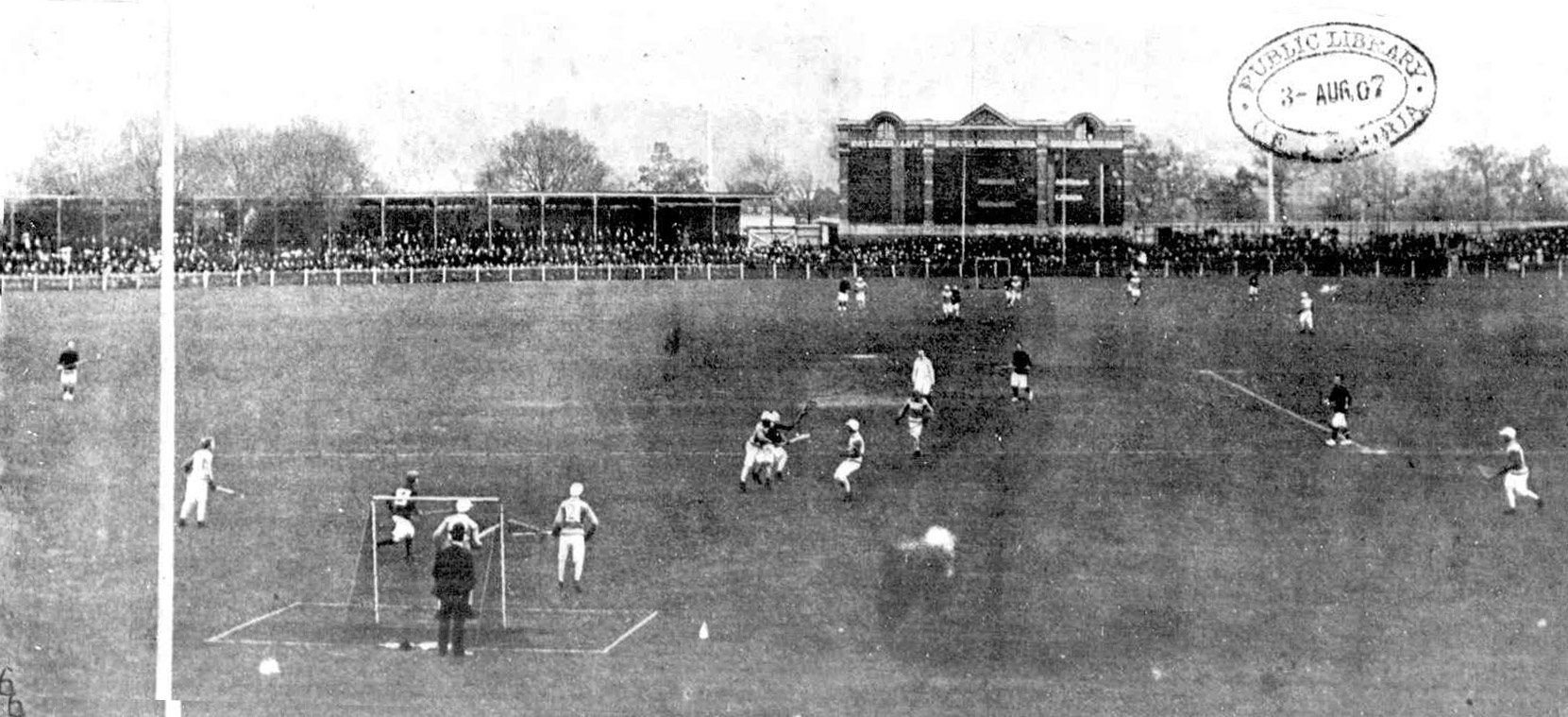
The Canadian Lacrosse Team at the Melbourne Cricket Ground, 1907 [18]
[1] "Constructing the Hockey Family, Home, Community, Bureaucracy and Marketplace". Proceedings of the "Putting it on ice" Hockey Conference, 2012, Lori Dithurbide and Colin Howell eds. St Mary's University, Halifax, NS, Canada. Chapter "The Skaters of Sydney and Streatham: Exporting Hockey to the British Empire between the Wars". Daryl Leeworthy, Huddersfield University, p 313
[2] Ibid., p 316
[3] The Argus, Melbourne, 18 Jul 1906, p 6
[4] The first rules for ice hockey are thought to have been published by James Creighton in the February 27th, 1877 edition of The Montreal Gazette in Quebec. There were only seven and, even today, few appreciate that they were virtually identical to previously published field hockey rules.
[5] The Advertiser, Adelaide, 15 October 1904, p 10. "The Ice Palace"
[6] Manitoba Hockey Hall of Fame article: Vics Reclaim Stanley Cup. Thanks to Jason Sangwin for this observation.
[7] The Australasian, 16 June 1906, p43
[8] Punch, Melbourne 6 June 1907 p 32
[9] Table Talk, 19 Jul 1906 p 28, 29.
[10] The Age, Melbourne, Tue 13 Aug 1907, p 4. "Hockey at the Glaciarium"
[11] The Argus, Melbourne, 13 Aug 1907 p 9, "The Canadians Victorious", and 14 Aug 1907
[12] Syd Tange, "Fact and Figures", 1999
[13] The Argus, Melbourne, 4 Sep 1908
[14] The Age, Melbourne, 2 Sep 1908, p 8, "Americans Defeated"
[15] Ibid., p 310
[16] "My Country Is Hockey", Brian Kennedy, 2010.
[17] Punch, Melbourne, 25 July 1907, p 13
[18] Leader, Melbourne, 3 Aug 1907, p 25. "International Lacrosse Canada vs Australia"
[19] Baltimore letter, pp 7 and 8, 1906, courtesy Jason Sangwin.


